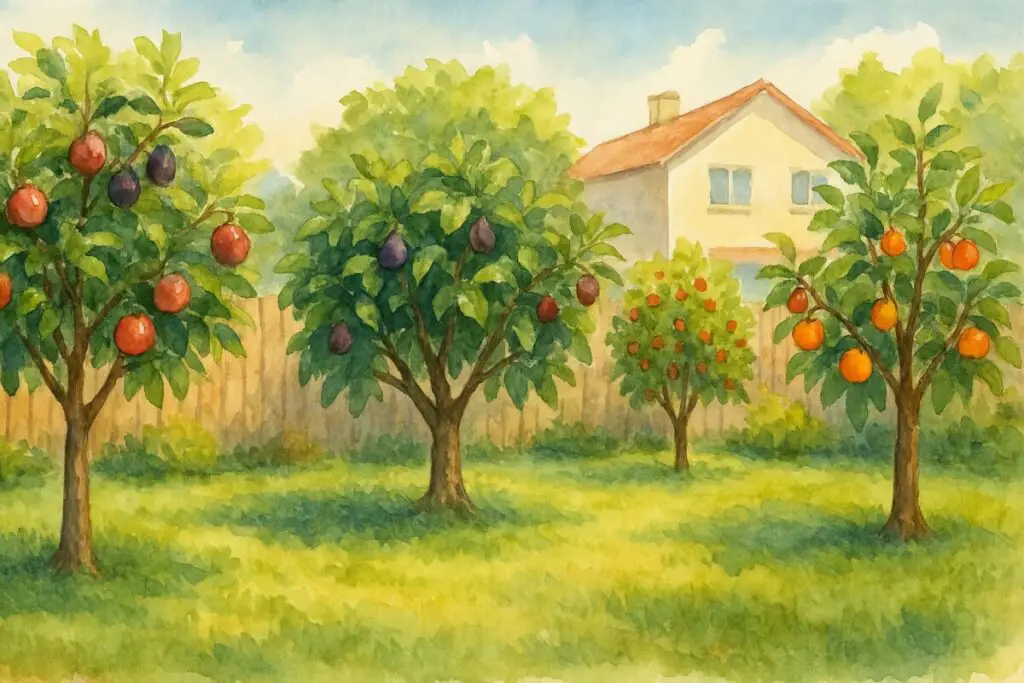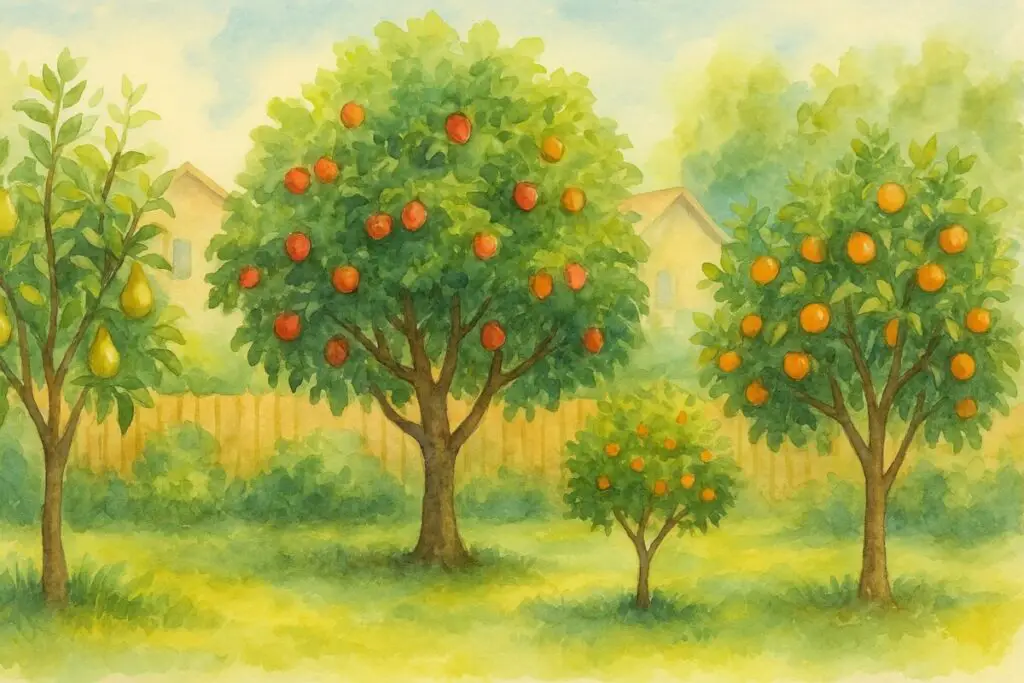
Introduction
Imagine stepping into your backyard on a crisp morning, greeted by the sight of sun-dappled branches heavy with ripe, juicy fruit. No weeding marathons, no pest-control nightmares – just nature doing its thing, with minimal effort on your part. Sounds like a dream, right? Well, it doesn’t have to be.
Low-maintenance fruit trees are the perfect solution for suburban gardeners who want the pleasure of harvesting their own produce without the fuss of constant upkeep. Whether you’re a beginner gardener, a busy professional, or just someone who prefers to keep things simple, these trees offer the best of both worlds: delicious fruit and easy care.
In this guide, we’ll introduce you to five of the best low-maintenance fruit trees that thrive in suburban backyards. From crispy apples to sweet figs, these varieties are known for their resilience, compact size, and generous yields. Say goodbye to tedious gardening and hello to a thriving backyard orchard that practically takes care of itself. Let’s dig in!
Why Choose Low-Maintenance Fruit Trees?
Life in the suburbs can be hectic – juggling work, family, and hobbies leaves little time for tending to high-maintenance plants. That’s why low-maintenance fruit trees are a game-changer for backyard gardeners. They offer the perfect blend of beauty, practicality, and productivity without demanding constant attention.
First off, these trees are tough. They’re typically more resistant to pests and diseases compared to their high-maintenance counterparts, saving you time and money on treatments and interventions. Plus, they’re often more drought-tolerant, which means fewer watering chores during dry spells.
Another major perk? Minimal pruning. While some fruit trees need meticulous trimming to produce well, the varieties on our list thrive with just the occasional snip to shape or remove dead branches. This makes them perfect for those who want the reward of homegrown fruit without the commitment of constant care.
And let’s not forget the payoff: fresh, organic fruit right at your doorstep. With the right choice of tree, you’ll enjoy a generous harvest year after year – no green thumb required. Low-maintenance fruit trees make backyard gardening accessible and rewarding, no matter your experience level.
Ready to plant your own effortless orchard? Keep reading to discover the top five picks that will transform your suburban backyard into a fruitful paradise!
Criteria for Low-Maintenance Fruit Trees
Not all fruit trees are created equal, especially when it comes to maintenance. To make your backyard gardening experience as hassle-free as possible, it’s essential to choose varieties that meet specific low-maintenance criteria. Here’s what to look for when selecting fruit trees for your suburban oasis:
1. Drought Tolerance
One of the most significant factors in low-maintenance gardening is water efficiency. Trees that can withstand dry spells without frequent watering are a blessing, especially during hot summer months or periods of water restrictions.
2. Pest and Disease Resistance
Choosing varieties that are naturally resistant to common pests and diseases will save you the headache of constant monitoring and treatment. This is particularly important in suburban areas where space is limited and pest issues can escalate quickly.
3. Minimal Pruning Requirements
Some fruit trees need regular pruning to stay healthy and productive, but low-maintenance varieties typically require far less. Look for self-maintaining trees or those that naturally grow in a compact, manageable shape.
4. Fast Fruit Production
Why wait years to enjoy the fruits of your labor? Opt for trees that bear fruit within a few seasons of planting. Early-producing varieties not only provide quicker satisfaction but also minimize the long-term effort needed for cultivation.
5. Compact Size
Space is often at a premium in suburban backyards. Compact or dwarf fruit trees are ideal because they fit comfortably into smaller plots while still offering abundant harvests. Plus, they’re easier to prune and maintain.
By focusing on these five criteria, you’ll ensure that your backyard fruit trees are not just productive but also manageable and resilient. Up next, we’ll dive into the top five low-maintenance fruit trees that perfectly fit the bill!
Top 5 Low-Maintenance Fruit Trees for Suburban Backyards

1. Apple Trees
Best Varieties: Fuji, Gala, Honeycrisp
Apple trees are a classic choice for suburban backyards, and for good reason. These hardy trees are known for their adaptability and low-maintenance requirements, making them a top pick for beginners and busy gardeners alike.
Why They’re Low Maintenance:
- Drought Tolerance: Once established, apple trees can withstand moderate drought, especially the Fuji and Gala varieties.
- Pest Resistance: Choose disease-resistant cultivars like Honeycrisp to minimize spraying and maintenance.
- Minimal Pruning: Regular light pruning in late winter keeps the shape and encourages fruiting, but they don’t need intense upkeep.
Growing Tips:
- Plant in well-drained soil with plenty of sunlight (at least 6-8 hours daily).
- Water deeply but infrequently once established.
- Mulch around the base to retain moisture and reduce weed competition.
Harvest Season and Yield:
Apple trees typically begin producing fruit within 3-4 years. Depending on the variety, expect ripe apples from late summer to early fall. One mature tree can yield up to 100-150 pounds of fruit annually!
2. Fig Trees
Best Varieties: Brown Turkey, Chicago Hardy
If you’re looking for a tree that practically thrives on neglect, figs are your best bet. These resilient trees are both ornamental and productive, yielding sweet, juicy figs with minimal fuss.
Why They’re Low Maintenance:
- Drought Tolerance: Once established, figs need very little watering.
- Pest and Disease Resistance: Figs are notably resistant to most common fruit tree pests.
- No Pruning Necessary: Figs naturally grow in a bushy, compact shape, which means no intensive pruning.
Growing Tips:
- Choose a sunny spot with well-drained, slightly acidic soil.
- Water sparingly once the tree is established.
- Protect young trees from frost by mulching heavily or using frost cloth.
Harvest Season and Yield:
Figs can produce fruit within 2-3 years. Depending on the variety, expect two harvests per year: one in early summer and another in late summer or early fall. A single tree can produce 20-50 pounds of fruit annually.
3. Plum Trees
Best Varieties: Santa Rosa, Methley
Plum trees are both beautiful and bountiful, with their fragrant blossoms and deliciously sweet fruit. These trees are ideal for suburban gardeners looking for something low-maintenance but highly rewarding.
Why They’re Low Maintenance:
- Drought Tolerance: Plum trees are relatively drought-resistant once mature.
- Self-Pollinating: Varieties like Santa Rosa and Methley don’t require a pollinator, saving you space and effort.
- Minimal Pruning: Light pruning in late winter or early spring is sufficient.
Growing Tips:
- Plant in loamy, well-drained soil with full sun exposure.
- Water regularly during the first few years, then reduce frequency.
- Apply mulch to retain soil moisture and suppress weeds.
Harvest Season and Yield:
Expect plums in mid-to-late summer, typically starting 3-5 years after planting. A mature tree can yield 30-50 pounds of fruit annually.
4. Persimmon Trees
Best Varieties: American Persimmon, Fuyu
Persimmon trees are often overlooked but deserve a spot in any suburban garden. Their glossy leaves and bright orange fruits add a splash of color, while their low-maintenance nature makes them an effortless choice.
Why They’re Low Maintenance:
- Drought and Pest Resistance: Once established, persimmons need little water and are rarely affected by pests.
- No Intensive Pruning: Only occasional thinning is necessary to improve airflow.
- Cold Hardiness: Varieties like American Persimmon can tolerate colder climates.
Growing Tips:
- Choose a location with full sun and well-drained, slightly acidic soil.
- Water regularly for the first few years, then reduce.
- Fertilize sparingly to avoid excessive leaf growth.
Harvest Season and Yield:
Persimmons typically start bearing fruit after 4-5 years. Harvest in late fall when the fruit is fully ripe. A mature tree can yield 50-75 pounds of fruit annually.
5. Cherry Trees
Best Varieties: Stella, Bing
Cherry trees are not just about delicious fruit – they also boast stunning spring blossoms. Compact and self-pollinating varieties make them perfect for suburban spaces.
Why They’re Low Maintenance:
- Compact Growth: Dwarf varieties are ideal for small yards.
- Self-Fruitful: Stella cherries don’t require a pollinator, saving you space and maintenance.
- Pest Resistance: Look for disease-resistant cultivars to minimize issues.
Growing Tips:
- Plant in a sunny spot with fertile, well-drained soil.
- Prune lightly to maintain shape and remove any damaged branches.
- Netting during fruiting season can prevent birds from eating your harvest.
Harvest Season and Yield:
Cherry trees begin fruiting after 3-4 years. Depending on the variety, you can expect cherries from late spring to early summer. A single tree can yield up to 50 pounds of fruit.
These five low-maintenance fruit trees are game-changers for suburban gardeners looking to enjoy fresh produce without dedicating countless hours to upkeep. In the next section, we’ll share expert tips to help you get the most out of your backyard orchard!
Expert Tips for Successful Fruit Tree Growing
Even the most low-maintenance fruit trees need a little TLC to thrive, especially when planted in suburban backyards. To help you maximize your harvest and keep your trees healthy, here are some expert tips to make your backyard orchard a success:
1. Soil Preparation
Healthy soil is the foundation of any thriving fruit tree. Start by testing your soil’s pH and nutrient levels. Most fruit trees prefer slightly acidic to neutral soil (pH 6.0-7.0).
Pro Tip: Adding organic mulch around the base of the tree not only helps retain moisture but also enriches the soil as it decomposes.
2. Watering Techniques
While these fruit trees are drought-tolerant once established, they still need consistent watering during their first few years. Aim to water deeply and infrequently rather than shallowly and often. This encourages deep root growth and increases drought resilience.
Pro Tip: Use a soaker hose or drip irrigation system to deliver water directly to the root zone without wetting the foliage, reducing the risk of fungal diseases.
3. Seasonal Care
Fruit trees may require extra attention at different times of the year:
- Spring: Apply a balanced, slow-release fertilizer to promote healthy growth.
- Summer: Keep an eye out for pests and water during dry spells.
- Fall: Prune to remove dead or damaged branches, but avoid heavy cuts.
- Winter: Protect young trees with mulch or burlap wraps in colder climates.
Pro Tip: Pruning in late winter before buds break promotes vigorous spring growth.
4. Pest and Disease Management
Though these trees are relatively low-maintenance, occasional pest problems can arise. Monitor your trees regularly for signs of disease or insect activity. Natural solutions like neem oil, horticultural soap, or homemade garlic spray can help control pests without harmful chemicals.
Pro Tip: Planting companion flowers like marigolds or lavender can naturally repel some pests and attract beneficial insects.
5. Pollination Strategies
While many of these trees are self-pollinating, planting multiple varieties can boost fruit production. Additionally, attracting pollinators like bees with flowering plants can increase your yield.
Pro Tip: Place a bee hotel nearby to encourage pollinators to stick around your garden.
6. Pruning and Shaping
While low-maintenance trees don’t require intense pruning, occasional thinning keeps them healthy and productive. Focus on removing crossing branches, weak growth, and any limbs that block sunlight from reaching the inner canopy.
Pro Tip: A well-ventilated, open canopy reduces the risk of fungal infections and improves fruit quality.
By following these expert tips, you’ll not only simplify your fruit tree care routine but also enjoy healthier trees and more bountiful harvests. In the next section, we’ll address some common questions to help you feel confident about growing your own backyard orchard!
FAQ Section
1. Do these low-maintenance fruit trees attract pests?
While low-maintenance fruit trees are generally more resistant to pests and diseases, they can still encounter issues if neglected. Choosing disease-resistant varieties and practicing good gardening habits, like regular monitoring and maintaining proper airflow through light pruning, can minimize problems. Additionally, using organic pest repellents like neem oil or planting companion flowers can help keep pests at bay.
2. Can these trees thrive in containers?
Yes, many of the low-maintenance fruit trees mentioned – especially dwarf or compact varieties – can thrive in large containers. Fig and cherry trees, in particular, are well-suited for container gardening. Ensure the container is at least 20 gallons, has good drainage, and use a high-quality, well-draining potting mix. Remember to water more frequently since containers dry out faster than ground soil.
3. How much space do I need between trees?
Spacing depends on the specific variety and whether you’re planting dwarf or standard-sized trees. As a general rule:
- Dwarf varieties: 8-10 feet apart
- Semi-dwarf varieties: 12-15 feet apart
- Standard varieties: 18-25 feet apart
Proper spacing ensures good air circulation and sunlight exposure, which are essential for healthy growth and abundant fruiting.
4. Are these trees suitable for colder climates?
Many of the recommended trees, such as apple and cherry varieties, can tolerate cold weather, especially if you choose cold-hardy cultivars. Fig and persimmon trees may need extra protection in colder regions, like mulching the base or wrapping young trees with burlap. Always check the USDA Hardiness Zone for your area before planting.
5. How long does it take for these trees to bear fruit?
While it varies by species and growing conditions, here’s a rough timeline:
- Apple Trees: 3-4 years
- Fig Trees: 2-3 years
- Plum Trees: 3-5 years
- Persimmon Trees: 4-5 years
- Cherry Trees: 3-4 years
Choosing grafted trees rather than seedlings can also shorten the wait time for your first harvest.
6. Can I grow multiple varieties together?
Absolutely! In fact, planting multiple varieties can increase your yield and ensure better pollination. One of my favorite books on the subject is “Grow a Little Fruit Tree” by Ann Ralph. Just make sure to consider the size and space requirements of each tree and their compatibility. For example, combining self-pollinating and non-self-pollinating varieties can boost overall productivity.
With these answers in mind, you’re well-equipped to start your backyard orchard confidently. Up next, let’s wrap up with some final thoughts and inspiration to get you planting!
Conclusion
Low-maintenance fruit trees are the unsung heroes of suburban gardening – they offer all the benefits of homegrown produce without the relentless upkeep. Whether you’re a beginner gardener looking to dip your toes into fruit cultivation or a seasoned green thumb aiming to simplify your backyard oasis, these trees are your perfect allies.
By choosing hardy, resilient varieties like apples, figs, plums, persimmons, and cherries, you’re setting yourself up for years of delicious harvests with minimal fuss. Their drought tolerance, pest resistance, and compact growth make them ideal for suburban spaces where time and room are limited.
Imagine the satisfaction of picking sun-ripened cherries or slicing into a juicy homegrown apple, all without spending countless hours pruning, spraying, or watering. These trees practically take care of themselves, giving you more time to enjoy your outdoor space.
If you’re ready to transform your backyard into a fruitful paradise, start by selecting one or more of these low-maintenance varieties. With the right care in the early stages, you’ll soon be reaping the rewards year after year.

